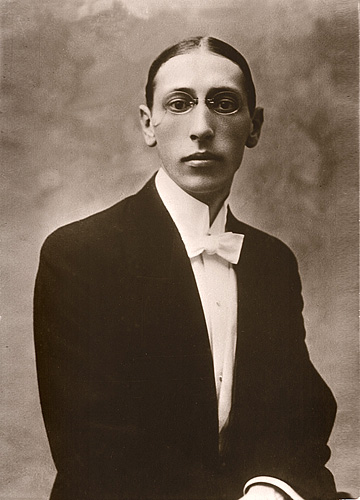Igor Stravinsky's The Rite of Spring
by Andy Boyd
Today, a Russian revolution. The University of Houston presents this series about the machines that make our civilization run, and the people whose ingenuity created them.
You could sense the excitement as the crowd gathered. Opening night at the Ballets Russes was always an event among the fashionable Parisian audiences. Founded by Russian impresario Sergei Diaghilev in the early twentieth century, the Ballet brought some of the finest dancers from Russia's storied dance troupes to Europe. Lavish productions were staged using revolutionary new choreographers, set designers, costume makers, and artists from all walks. But the Ballet also brought something even more revolutionary: provocative new music from a growing Russian movement.

A posed group of dancers in the original production of Igor Stravinsky's ballet The Rite of Spring, showing costumes and backdrop by Nicholas Roerich. Photo Credit: Wikimedia
By 1913 Parisian's had experienced a host of avant-garde works, including Igor Stravinsky's Petrushka and The Firebird. But that didn't prepare them for Stravinsky's momentous work The Rite of Spring.

Igor Stravinski postcard Photo Credit: Wikimedia
The Rite of Spring tells a stylized story of life in rural Russia, where the arrival of spring was no less than the arrival of life. Written in two parts, the ballet opens with themes of pagan adoration rituals of the earth and concludes with the sacrificial death of a young girl. Stravinsky drew upon folk tunes of the era, including the haunting opening melody.
[opening to The Rite of Spring]
It wasn't, however, the melodic moments that proved dissonant with audiences. To portray humankind's earthen roots, Stravinsky needed instruments whirling; drums pounding. And what he created was less a musical composition than a musical experience.
[excerpt from The Rite of Spring]
History paints a tumultuous picture of opening night, with crowds rising from their seats to throw whatever they could find at the stage, and yelling so loudly the dancers couldn't hear the music. Of course, stories are susceptible to embellishment over time, and more recent accounts call into question the reports of an all-out riot. But there's no questioning the profound significance of Stravinsky's creation and its impact on Western music. Though Italian composer Giacomo Puccini once called it "the work of a madman," today it's considered a masterwork - one that music students will invariably encounter in their studies.

Russian Ballet in Paris 1913 article - New York Times Photo Credit: Wikimedia
As demonstrated in Paris on opening night, The Rite of Spring isn't to everyone's taste. But as also demonstrated that night, it most definitely evokes an emotional response.
[excerpt from The Rite of Spring]
I'm Andy Boyd at the University of Houston, where we're interested in the way inventive minds work.
(Theme music)
The recording of The Rite of Spring was performed by the London Symphony Orchestra under the direction of Sir Eugene Goossens.
No alt. From the Ballets Russes website: www.ballets-russes.com/dance.html. Accessed July 19, 2017.
Tom Service. The Rite of Spring: 'The Work of a Madman.' From The Guardian website: https://www.theguardian.com/music/2013/feb/12/rite-of-spring-stravinsky. Accessed July 19, 2017.
Stravinsky's The Rite of Spring. From the Keeping Score website: http://www.pbs.org/keepingscore/stravinsky-rite-of-spring.html. Accessed July 19, 2017.